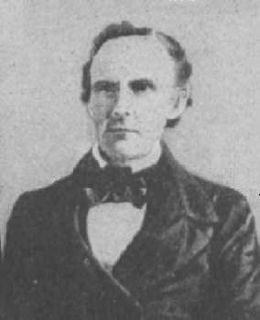
The Republic of Texas was a sovereign nation in North America that existed from October 2, 1835, to February 19, 1846. It was bordered by Mexico to the west and southwest, the Gulf of Mexico to the southeast, the two U.S. states of Louisiana and Arkansas to the east and northeast, and United States territories encompassing parts of the current U.S. states of Oklahoma, Kansas, Colorado, Wyoming, and New Mexico to the north and west. The citizens of the republic were known as Texians.

The Battle of San Jacinto, fought on April 21, 1836, in present-day Harris County, Texas, was the decisive battle of the Texas Revolution. Led by General Sam Houston, the Texian Army engaged and defeated General Antonio López de Santa Anna's Mexican army in a fight that lasted just 18 minutes. A detailed, first-hand account of the battle was written by General Houston from Headquarters of the Texian Army, San Jacinto, on April 25, 1836. Numerous secondary analyses and interpretations have followed, several of which are cited and discussed throughout this entry.

John Bowden Connally Jr. was an American politician. He served as the 39th Governor of Texas and as the 61st United States Secretary of the Treasury. He began his career as a Democrat and later became a Republican in 1973.

The Texas annexation was the 1845 annexation of the Republic of Texas into the United States of America, which was admitted to the Union as the 28th state on December 29, 1845.

The United States Department of War, also called the War Department, was the United States Cabinet department originally responsible for the operation and maintenance of the United States Army, also bearing responsibility for naval affairs until the establishment of the Navy Department in 1798, and for most land-based air forces until the creation of the Department of the Air Force on September 18, 1947.

The several branches of the United States Armed Forces are represented by flags, with the exception of the U.S. Space Force which has yet to adopt any. Within the U.S. military, various flags fly on various occasions, and on various ships, bases, camps, and military academies.

Gordon Richard England is an American politician and businessman who was the U.S. Deputy Secretary of Defense and twice as U.S. Secretary of the Navy in the administration of U.S. President George W. Bush.

Abel Parker Upshur was a lawyer, planter, slaveowner, judge and politician from the Eastern Shore of Virginia. Active in Virginia state politics for decades, with a brother and a nephew who became distinguished U.S. Navy officers, Judge Upshur left the Virginia bench to become the Secretary of the Navy and Secretary of State during the administration of President John Tyler, a fellow Virginian. He negotiated the treaty that led to the 1845 annexation of the Republic of Texas to the United States and helped ensure that it was admitted as a slave state. Upshur died on February 28, 1844, when a gun on the warship USS Princeton exploded during a demonstration.

Thomas Jefferson Rusk was an early political and military leader of the Republic of Texas, serving as its first Secretary of War as well as a general at the Battle of San Jacinto. He was later a US politician and served as a Senator from Texas from 1846 until his suicide. He served as the President pro tempore of the United States Senate in 1857.

Robert Bernard Anderson was an American administrator and businessman. He served as the Secretary of the Navy between February 1953 and March 1954. He also served as the Secretary of the Treasury from 1957 until 1961, and was one of President Eisenhower's closest confidants. Two years before his death from cancer, he was disbarred for illegal banking operations and tax evasion.

Edwin Ward Moore, was an American naval officer who also served as Commander-in-chief of the Navy of the Republic of Texas.
Samuel Rhoads Fisher was the secretary of the Navy of the Republic of Texas.

The Texas Navy, officially the Navy of the Republic of Texas, also known as the Second Texas Navy, was the naval warfare branch of the Texas Military Forces during the Republic of Texas. It descended from the Texian Navy, which was established in November 1835 to fight for independence from Centralist Republic of Mexico in the Texas Revolution. The Texas Navy, Texas Army, and Texas Militia were officially established on September 5, 1836 in Article II of the Constitution of the Republic of Texas. The Texas Navy and Texas Army were merged with the United States Armed Forces on February 19, 1846 after the Republic of Texas became the 28th state of America.
The Texas Military Forces (TXMF) are the principle instrument through which the Texas Military Department (TMD) executes security policy for Texas, which has the second largest population and border in the United States, and the tenth largest economy in the world.
The Texas schooner Invincible was one of the four schooners of the Revolutionary Texas Navy (1836-1837). She began her service in January 1836 and immediately began attacking ships supplying the Mexican army in Texas, including capturing the United States merchant vessel Pocket and later the British ship Eliza Russell. Both of these actions caused diplomatic incidents between the Republic of Texas and the United States and the United Kingdom.

Memucan Hunt was the first Minister of Texas to the United States, Secretary of the Texas Navy, and an unsuccessful candidate for Vice-President of the Republic of Texas.

John Austin Wharton was distinguished as a statesman, a lawyer, and a soldier. He served as Adjutant General at the Battle of San Jacinto. In a eulogy at his grave, Republic of Texas President David G. Burnet said of him, "The keenest blade on the field of San Jacinto is broken." He died a bachelor on December 17, 1838, while serving as a member of the Texas Congress. His nephew, John A. Wharton, who would go on to be a Confederate Army general, was named for him.
Richard Franklin Bache, also known as Richard Bache Jr. (1784–1848), was a military and political official in the Republic and state of Texas. He assisted in drafting the Texas Constitution of 1845, the first of its five state constitutions.

Branch Tanner Archer was a Texan who served as Commissioner to the United States and Speaker of the House of the Republic of Texas House of Representatives and Secretary of War of the Republic of Texas.

The Texian Navy, also known as the Revolutionary Navy and First Texas Navy, was the naval warfare branch of the Texian armed forces during the Texas Revolution. It was established by the Consultation of the Republic of Texas on November 25, 1835. Along with the Texian Army, it helped the Republic of Texas win independence from the Centralist Republic of Mexico on May 14, 1836 at the Treaties of Velasco. It was replaced by the Texas Navy on March 23, 1839.















